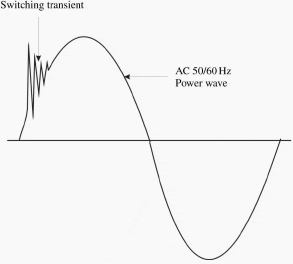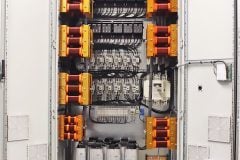Power Quality Issue
As you know, deviation from sinusoidal form at the nominal voltage level is actually a power quality issue or power disturbance, defined as “any deviation from the nominal value (or from some selected thresholds based upon tolerance) of the AC input power characteristics”.

Power disturbances can greatly affect utilization equipment. For example, sensitive electronic medical equipment can malfunction, adjustable speed motor drives may trip off-line, etc.
Interruptions can cause microprocessor-based equipment such as computers to lose data. In extreme conditions, such as for voltage surges caused by direct lightning strikes, both power equipment and utilization equipment may be subject to failure.
The most common power disturbances are, as defined by:
1. Overvoltage:
What happens? An RMS increase in the AC voltage, at the power frequency, for a period of time greater than 1 min. Typical values are 110%-120% of nominal.
2. Undervoltage
What happens? An RMS decrease in the AC voltage, at the power frequency, for a period of time greater than 1 min. Typical values are 80-90% of nominal.
3. Swell

What happens? An increase in RMS voltage or current at the power frequency for durations from .5 cycle-1 min. Typical values are 110%-180% of nominal.
4. Sag

What happens? An RMS reduction in the AC voltage, at the power frequency, for durations from _ cycle to a few seconds.
5. Interruption

What happens? The complete loss of voltage. Amomentary interruptionis a voltage loss (<10% of nominal) for a time period between .5 cycles and 3 seconds). Atemporary interruptionis a voltage loss (<10% of nominal) for a time period between 3 seconds and 1 min
6. Notch
What happens? A switching (or other) disturbance of the normal power system voltage waveform, lasting less than _ cycle; which is initially of opposite polarity to the waveform, and is thus subtractive from the normal waveform in terms of the peak value of the disturbance voltage.
This includes a complete loss of voltage for up to _ cycle.
7. Transient

What happens? A subcycle disturbance in the AC waveform that is evidenced by a sharp discontinuity of the waveform. May be of either polarity and may be additive to, or subtractive from, the nominal waveform.
8. Flicker
What happens? A variation in input voltage, either magnitude or frequency, sufficient in duration to allow visual observation of a change in electric light source intensity.
9. Harmonic Distortion

What happens? The mathematical representation of distortion of the pure sine waveform. This refers to the distortion of the voltage and/or current waveform, due to the flow of non-sinusoidal currents.
10. Electrical Noise
What happens? Unwanted electrical signals that produce undesirable effects in the circuits of the control systems in which they occur. Noise may be further categorized as transverse-mode noise, which is measurable between phase conductors but not phase-to-ground, and common-mode noise, which is measurable phase-toground but not between phase conductors.
The causes of the common power disturbances listed can vary greatly. Common causes are listed in Table below:
Common Power Disturbance Causes
| Disturbance | Common Causes |
| Overvoltage | • Voltage regulator malfunction • Improperly set transformer taps • Improperly-applied power factor correction capacitors |
| Undervoltage | • Voltage regulator malfunction • Improperly set transformer taps • Large source impedance (“weak” system) |
| Voltage Swell | • Recovery of system voltage following a fault • Remote switching (capacitors, etc. |
| Voltage Sag | • Remote fault • Cold-load pickup (motor starting, transformer energization, etc.) • Large step loads |
| Transient (Typically voltage surges) | • Lightning strikes • Close-in switching (capacitors, etc.) • Complex circuit phenomena such as current chopping, restrikes, system resonance, etc. |
| Flicker | • Arcing loads such as arc furnaces • Also same sources that cause voltage sags and swells |
| Notches and Harmonic Distortion | • Power electronic converter equipment such as rectifiers, inverters, drives, etc., which produce nonsinusoidal load current and commutation notches |
| Interruptions | • Faults causing overcurrent protective device operation • Utility maintenance activities |
| Electrical Noise | • Power electronic converter equipment such as drives • Conductors and power equipment which carry large amounts of current • Arcing in overcurrent protective devices |
Reference: Power Quality Considerations – Bill Brown, P.E., Square D Engineering Services











I am in need complete information for motor current signature analysis
Thanks for cooperation
Thanks for all the info.
As an Electrical Engineering lecturer, your posts keeps me well informed to assist the students
Nice. Thank you a lot!!